SECTION 13-K 1957 BUICK DOORS AND CENTER PILLAR (SERIES 50-70)
13-30 1957 BUICK FRONT AND REAR DOORS (SERIES 50-70)
Many changes have been incorporated in the design of the front and rear doors which require new service methods. All 1957 Buick doors are equipped with a waterproof door inner panel water deflector which is sealed to the door inner panel. The bottom edge of the deflector is positioned into a slot along the bottom of the door panel, thereby, deflecting any water into the bottom of the door and out the door bottom drain holes. Door lock levers are provided with redesigned spring clips which facilitate easier attachment of the connecting rods. The front and rear door hinges are similar in design to past models, however, the method of attachment to the front body hinge pillar or center pillar differs with respect to the accessibility of the attaching bolts or screws.
On front and rear doors, particular attention should be given to the door and door window adjustments to provide proper window operation and proper window frame contact with the new side roof rail weatherstrip.
The 1957 Buick door section is divided into the following parts: service operations which are the same or similar for both the front and rear doors, service operations for the front door, and service operations for the rear door.
Removal and Installation of 1957 Buick Front and Rear Door Inside Handles
- Depress 1957 Buick door trim assembly at handle. Insert spring removing tool between handle and escutcheon and remove handle retaining spring; then remove handle anti-friction and escutcheon.
- To install, first install retaining spring and assemble anti-friction washer on handle; then position escutcheon and handle or regulator spindle and push handle until spring clip is engaged. NOTE: Install handle at same angle as handle on opposite door. Window or ventilator should be in closed position when checking angle of handle.
1957 Buick Front Door Belt Finishing Moldings
The 1957 Buick front doors are equipped with an upper and lower door belt finishing molding. The upper molding must be removed to remove the lower molding.
- Removal and Installation of Upper Belt Finishing Molding.
- Open 1957 Buick door and remove inside locking rod knob. Remove one molding attaching screw at each end of molding.
- Lift molding upward and inward and remove from 1957 Buick door.
- To install upper belt finishing molding, reverse removal procedure.
- Removal and Installation of Lower Belt Finishing Molding.
- Remove upper belt finishing molding. (b) At cove area of door hinge pillar carefully remove two molding attaching screws, located under door hinge pillar auxiliary weatherstrip; then remove one molding attaching screw at rear of molding.
- Disengage molding tabs from under hinge pillar auxiliary weatherstrip. Then move molding forward to disengage molding from clip under door trim assembly at lower rear of molding and remove molding from 1957 Buick door.
- To install lower belt finishing molding, reverse removal procedure.
Removal and Installation of Rear Door Belt Finishing Molding (Four-Door Models)
- Open 1957 Buick door and remove inside locking rod knob. Remove two molding attaching screws at each end of molding. Lift molding upward and remove from door.
- To install rear door belt finishing molding, reverse removal procedure.
1957 Buick Door Arm Rest
The 1957 Buick door arm rest is secured to a hanger plate by two screws located on the underside of the arm rest. The arm rest hanger plate is secured over the trim assembly to the door inner panel by two screws located behind the arm rest.
Removal and installation of 1957 Buick Front and Rear Door Electric Window Control Switch
- Remove 1957 Buick door belt finishing molding and door inside handles.
- On 1957 Buick front doors, remove door trim assembly. On 1957 Buick rear doors, loosen upper portion of trim assembly sufficiently to disconnect terminal block from switch assembly by pulling block from switch terminals.
- Carefully push switch assembly from trim assembly to release switch from retainer. NOTE: In some instances, it may be necessary to pry open retainer tabs to release switch.
- To remove switch from escutcheon, depress clips at sides of switch with pointed tool inserted through holes in sides of escutcheon.
- To install control switch, reverse removal procedure. NOTE: The feed stud of the master control switch should be towards the rear of the body when installed in trim assembly. Check operation of switch before completing installation of parts.
Removal and Installation of 1957 Buick Front and Rear Door Trim Assemblies
1957 Buick Door trim assemblies are secured to the door inner panel by a nailing strip along the front and rear edge of the trim assembly, by a trim retainer along the bottom of the door and by one or two retaining tabs on the door inner panel.
- Remove 1957 Buick door inside handle, escutcheons, and door belt finishing molding.
- On four-door styles, remove screw securing door belt finishing molding front and/or rear finishing plates where present, and remove plates.
NOTE: A finishing plate is located at rear edge of rear door inner panel. - Remove door arm rest and door arm rest hanger plate.
- With a clean mallet, tap trim assembly along front and rear edges to free trim assembly nails in retainer slots.
- Place a suitable flat-bladed tool between 1957 Buick door trim assembly and inner panel water deflector and carefully pry front and rear edges of door trim assembly from door inner panel. CAUTION: Exercise extreme care so as not to damage water deflector.
- Lift trim assembly upward to disengage it from retaining tabs and from metal retainer which is located along lower edge of 1957 Buick door inner panel.
- On doors equipped with electrically powered window regulators, carefully pull terminal block from switch terminals, then remove trim assembly.
- To install, reverse removal procedure. Make certain tension springs are reinstalled over 1957 Buick door handle spindles where required, and that trim assembly is engaged with retainer tabs and metal retainer before tapping in nail strips at front and rear edges of trim assembly. NOTE: If during removal of trim assembly, any retaining nails are broken off, they can be replaced with door trim assembly nailing strip replacement tabs which are available as a service part.
Removal of 1957 Buick Front and Rear Door Water Deflectors
A 1957 Buick door water deflector consisting of waterproof paper secured to the door inner panel by an elastic double-sided sealing tape is provided on the doors of all styles. The deflector, which covers the complete door inner panel, fits into a slot along the bottom of the door inner panel and deflects water into the bottom of the door where it can drain out the door bottom drain holes. Whenever any work is performed on a door where the water deflector has been disturbed, the deflector must be properly sealed and attached to the inner panel as specified below.
- Remove 1957 Buick door belt finishing molding and door trim assembly.
- Where present, remove screws securing molding finishing plate (s), door trim pad retaining tabs and arm rest hanger plate and remove parts. On ModP.ls 53-73, remove trim assembly spacer secured by one (1) screw.
- Carefully remove water deflector from 1957 Buick door. Use caution that dirt or foreign matter does not get on exposed surface of tape and destroy adhesive qualities of tape.
Installation of 1957 Buick Front and Rear Door Water Deflectors
- Prior to installing water deflector, make certain surface of inner panel or water deflector contacted by sealing tape is free of any foreign material to insure a satisfactory seal. NOTE: If adhesive quality of sealing tape has been damaged, cover affected area with an additional strip of tape or weatherstrip cement to insure a proper weatherseal.
- On front doors, apply waterproof body tape over the lower hinge access hole, as indicated in figure 13-185.
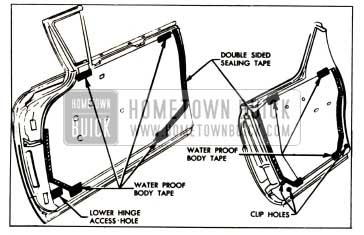
1957 Buick Front and Rear Door Water Deflector Installation
On rear doors, apply body caulking compound over clip holes at bottom of inner panel, as indicated in figure 13-185.
- Inspect water deflector and where necessary, repair any tears or holes with waterproof body tape applied to both sides of deflector.
- Insert bottom edge of water deflector in slot across bottom of inner panel. Align holes in water deflector with regulator spindles and inside trim and hardware installation holes. When properly aligned, press or roll edges of water deflector to inner panel to effect a watertight seal.
- Tape upper and lower corners of water deflector to inner panel with 2-inch strips of waterproof body tape, as indicated in figure 13-185.
- Install previously removed 1957 Buick door trim and inside hardware.
Removal and Installation of 1957 Buick Front and Rear Door Lock Striker
- With a pencil, scribe position of striker on body pillar.
- Remove three door lock striker attaching screws and remove striker and adjusting plates from pillar.
- To install, place striker and adjusting plates within scribe marks on pillar and tighten screws. IMPORTANT: Whenever a door has been removed and installed, or realigned, the 1957 Buick door SHOULD NOT be closed completely until a visual check is made to determine if the lock extension will engage in the striker notch. Where required, door lock striker emergency spacers should be installed so that door can be closed and an accurate check made to determine emergency spacer requirements.
1957 Buick Door Lock Striker Adjustments
- To adjust striker “up” or “down” or “in” or “out” loosen striker plate attaching screws and shift striker and adjusting plates as required, then tighten screws.
- DIMENSIONAL SPECIFICATIONS FOR USE OF DOOR LOCK STRIKER EMERGENCY SPACERS.
- Door(s) should be properly aligned before checking door spacer requirements.
- To determine if 1957 Buick door lock striker emergency spacers are required, apply modeling clay or body caulking compound in the door lock striker notch where the lock extension engages and then close the door to form a measurable impression in the clay or caulking compound, as shown in figure 13-186.
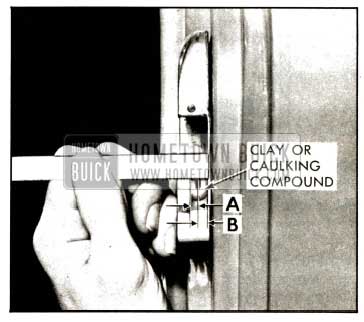
1957 Buick Striker Engagement Check
When dimension “A” from inside face of striker teeth to center of lock extension is less than 5/16″, install emergency spacers and proper length striker attaching screws as directed below.
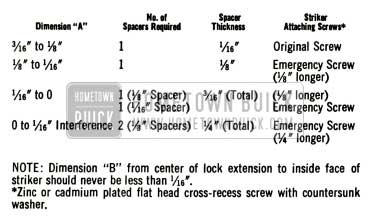
1957 Buick Door Striker Attaching Screws
NOTE: Dimension “B” from center of lock extension to inside face of striker should never be less than 1/16”.
*Zinc or cadmium plated flat head cross-recess screw with countersunk washer.
Removal of 1957 Buick Front and Rear Door Weatherstrips
Both the front and rear door weatherstrips are a one-piece mechanically retained type with external clips formed from a wire insert extending through the length of the weatherstrip. The weatherstrips are secured to the 1957 Buick door by snapping the weatherstrip clips into holes around the perimeter of the door. After a weatherstrip is installed, sealer is applied through the inner panel access holes to the weatherstrip attaching clips along the bottom of the door and to the lower clip on each pillar. The ends of the weatherstrips are provided with integral tabs which are secured to the door pillars by screws. In addition, front door weatherstrips are cemented to the door hinge pillar along the cove area. A front door hinge pillar auxiliary weatherstrip is provided to direct any water in the cove area of the hinge pillar into a drainage hole in the hinge pillar. The auxiliary weatherstrip is cemented to the door hinge pillar and has two snap-on clips at the lower and one at the upper end of the weatherstrip.
- Remove 1957 Buick door belt finishing molding and remove screws securing weatherstrip tabs at upper ends of door pillars, indicated at A, B, C and F in figure 13-187.
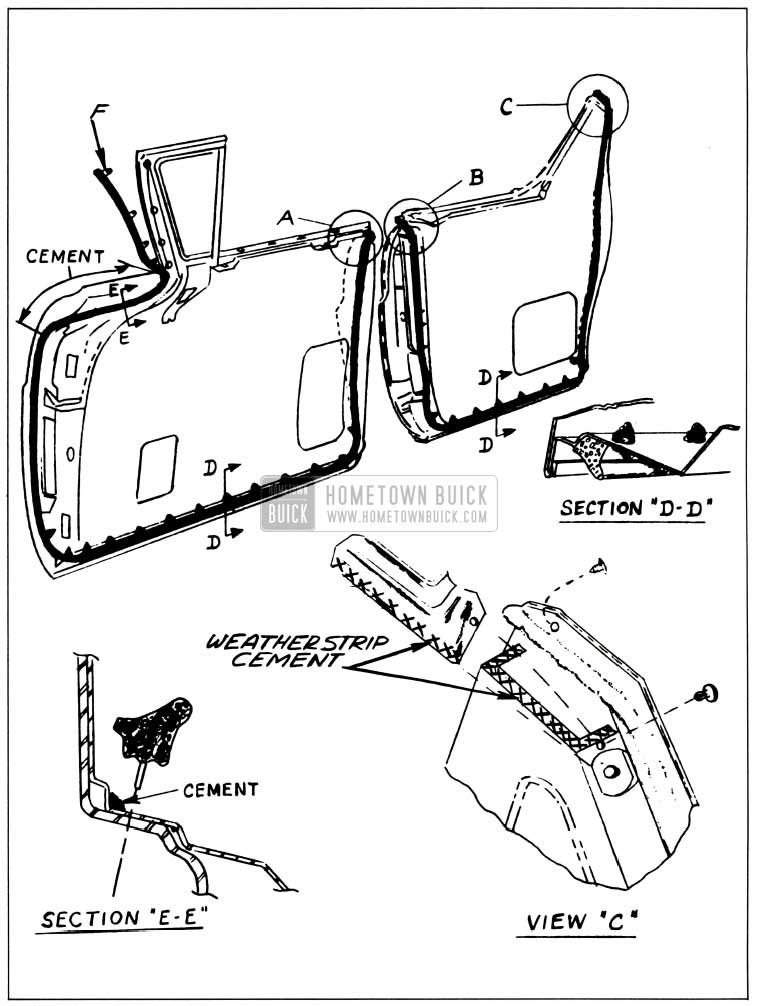
1957 Buick Front and Rear Door Weatherstrips Illustration
- Using a mechanically retained weatherstrip inserting tool or other suitable tool, carefully position tip of tool under weatherstrip at each clip location and snap clip out of hole.
Installation of 1957 Buick Front and Rear Door Weatherstrips
- Remove 1957 Buick door trim assembly and inner panel water deflector. NOTE: Before installing weatherstrip, reform any deformed clips, using Clip Reformer Tool No. J-5981, as shown in figure 13-188.
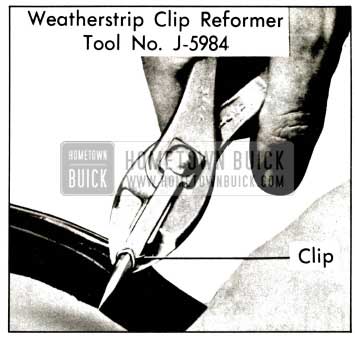
1957 Buick Weatherstrip Clip Reforming Tool
- Locate weatherstrip on 1957 Buick door, then install weatherstrip clips into clip holes. On front doors, apply an approved weatherstrip cement along the entire length of the cove area, indicated in Fig. 13-187, Section “E-E.” Start installation at cove area of hinge pillar. To install clips into clip holes, place “V-shaped” tip of weatherstrip inserting tool on loop of clip, then push clip into hole until it snaps into position. CAUTION: Do not use excessive force or strike tool when pushing clips into holes as it may distort shape of clip, resulting in improper weatherstrip retention.
- Install weatherstrip tab attaching screws at upper ends of door pillars, at A, B, C and F in figure 13-187.
- Working through large access hole, apply medium-bodied sealer over and around weatherstrip attaching clips, as indicated in figure 13-187, Section “D-D.” Seal all clips along door bottom and lower clip at door pillars.
- Install 1957 Buick door inner panel water deflector, door trim assembly and belt finishing molding.
Removal and Installation of 1957 Buick Rear Door Lock Pillar Upper Sealing Strip (Four-Door Models)
The rear door lock pillar upper sealing strip has a retaining lip on the inner portion of the sealing strip which is cemented to a flange at the top of the door inner panel and lock pillar. The sealing strip is also secured by a snap-on fastener, as indicated in View “C,” figure 13-187.
- To remove sealing strip, remove snap-on fastener with a flat-bladed tool. Carefully break cement bond and disengage sealing strip retaining lip from flange of door inner panel and lock pillar and remove strip from 1957 Buick door.
- To install sealing strip, apply an approved weatherstrip cement to the retaining lip of sealing strip and attaching flange on door. Install sealing strip to door and install snap-on fastener. Make sure retaining lip of sealing strip is positioned over flange on 1957 Buick door.
Removal of 1957 Buick Front Door Hinge Pillar Auxiliary Weatherstrip
With a flat-bladed tool carefully remove three snap-on fasteners securing weatherstrip, then break cement bond and remove weatherstrip from 1957 Buick door pillar. See figure 13-189.

1957 Buick Front Door Hinge Pillar Auxiliary Weatherstrip
Installation of 1957 Buick Front Door Hinge Pillar Auxiliary Weatherstrip
- Clean off old cement from area of hinge pillar contacted by weatherstrip.
- Apply an approved weatherstrip cement to the surface of the hinge pillar contacted by the weatherstrip and to the weatherstrip attaching surface.
- Install weatherstrip to hinge pillar, aligning snap-on clips in weatherstrip with holes in hinge pillar.
- Install snap-on clips. Firmly press entire length of weatherstrip to hinge pillar to assure a complete cement bond.
- Clean off any excess cement.
1957 Buick Front and Rear Door Bottom Drain Hole Sealing Strips
A new door bottom drain hole sealing strip is attached to the 1957 Buick door inner panel over the drain holes by a snap-on fastener at each end of the strip.
To prevent the strip from adhering to the door inner panel and blocking the drain holes, apply a sparing amount of silicone rubber lubricant on the center section of the weatherstrip as indicated in figure 13-190.
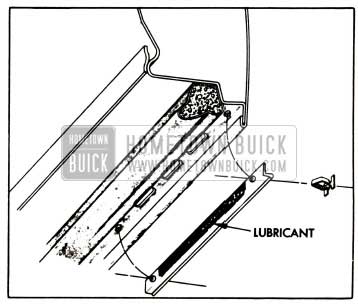
1957 Buick Front and Rear Door Bottom Drain Hole Sealing Strip
Removal and Installation of Front Body Hinge Pillar Auxiliary Weatherstrip
The front body hinge pillar auxiliary weatherstrip is a one-piece mechanically-retained weatherstrip with external clips formed from the wire insert extending through the length of the weatherstrip. The weatherstrip is positioned on the upper portion of the front body hinge pillar.
- Carefully position tip of mechanically retained weatherstrip inserting tool, or other suitable tool, under weatherstrip at each clip location and snap clip out of hole. Then remove weatherstrip.
- To install, first check clips for proper contour and reform if necessary using Tool No. J-5984 as indicated in figure 13-188, then position weatherstrip to hinge pillar and install clips into holes with mechanically-retained weatherstrip inserting tool. To install clips in holes, place “V”-shaped tip of tool on loop and push clip into hole. CAUTION: Do not use excessive force or strike tool when pushing clips into holes as it may distort shape of clips and cause improper weatherstrip retention.
Removal of 1957 Buick Side Roof Rail Weatherstrip (Four-Door Models)
The newly designed side roof rail weatherstrip is a one-piece mechanically-retained type with external clips formed from a wire insert extending through the length of the weatherstrip. In addition to the clips the weatherstrip is secured by a side roof rail weatherstrip retainer and reveal molding which is attached to the side roof rail by screws.
IMPORTANT: As the center of the weatherstrip a section (approximately ten inches long) is provided with a reinforced outer skin to prevent excessive wear from the rear door window upper frame during closing and opening of the 1957 Buick door. This reinforced section of the weatherstrip should be correctly located to properly perform its function.
Disengage weatherstrip from outer flange of retainer; then with a mechanically-retained weatherstrip inserting tool, or other suitable tool, carefully position tip of tool under weatherstrip at each clip location and snap clip out of hole.
Installation of 1957 Buick Side Roof Rail Weatherstrip
- Check weatherstrip clips for proper contour and reform if necessary using Tool No. J-5984 (see figure 13-188) in Door Weatherstrip section.
- Position weatherstrip to retainer at side roof rail so that reinforced section (approximately ten inches long) is over front edge of the rear door window upper frame. Install weatherstrip clips into clip holes with mechanically-retained weatherstrip inserting tool. to install clips into holes, place “V”-shaped tip of tool on loop of clip, then push clip into hole, as shown in figure 13-191, until it snaps into position. CAUTION: Do not use excessive force or strike tool when pushing clips into holes as it may distort shape of clips resulting in improper weatherstrip retention.
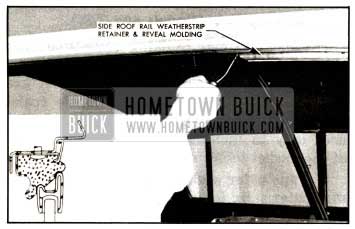
1957 Buick Side Roof Rail Weatherstrip Illustration
- Engage weatherstrip in both the inner and outer flange of retainer along entire length of retainer.
- If installing a new weatherstrip carefully trim front and rear ends to provide a proper weather seal and a neat appearance at body windshield pillar and rear body lock pillar.
NOTE: With 1957 Buick doors and windows closed, ventilator and front and rear door window upper frame should make an even continuous contact, as indicated in inset of figure 13-191, with the side roof rail weatherstrip. For side roof rail weatherstrip adjustments see “SIDE ROOF RAIL WEATHERSTRIP RETAINER AND REVEAL MOLDING-ADJUSTMENTS.”- Lubricate side roof rail weatherstrip as directed under “LUBRICATION” section.
Removal of 1957 Buick Side Roof Rail Weatherstrip Retainer and Reveal Molding (Four-Door Models)
The side roof rail weatherstrip retainer and reveal molding is a channel-type molding secured to the side roof rail by nine screws. The assembly may be adjusted “in” or “out”; however, the amount of adjustment is small and is not intended to correct for improper ventilator or door window alignment. It is important that the ventilator and the front and rear doors are checked and, if necessary, aligned for proper contact with the side roof rail weatherstrip.
- Remove side roof rail weatherstrip from retainer.
- Remove screws securing side roof rail weatherstrip retainer and reveal molding to side roof rail and remove molding. NOTE: Exercise care during removal so as not to bend molding as this may affect proper weatherseal after installation.
Installation of Side Roof Rail Weatherstrip Retainer and Reveal Molding (Four-Door Models)
- Remove sealer from side roof rail and molding to insure a clean sealing surface.
- Apply medium-bodied sealer along upper rabbet of retainer and reveal molding, as shown in figure 13-192, along entire length of molding.
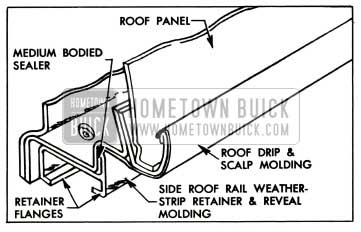
1957 Buick Side Roof Rail Weatherstrip Retainer and Molding Sealing
- Position weatherstrip retainer and reveal molding to side roof rail and secure in place by installing screw at front, center, and rear of molding. Then install remaining screws.
- Install side roof rail weatherstrip.
1957 Buick Side Roof Rail Weatherstrip Retainer and Reveal Molding Adjustments
The attaching holes in the side roof rail weatherstrip retainer and reveal molding are elongated allowing “in” and “out” adjustment of the side roof rail weatherstrip, however, the amount of adjustment is small and is not intended to correct for improper ventilator or 1957 Buick door window alignment. The retainer attaching screws are located under the weatherstrip necessitating removal of the weatherstrip to make an adjustment.
IMPORTANT: Before attempting to adjust the side roof rail weatherstrip first check that the ventilator and front and rear door windows are properly aligned and, where necessary, adjust for proper alignment as directed under “ADJUSTMENTS” in the Ventilator, Front Door Window and Rear Door Window service procedures.
- To adjust side roof rail weatherstrip “in” or “out” first determine and mark retainer at area or areas to be adjusted; then remove side roof rail weatherstrip.
- Loosen weatherstrip retainer attaching screws slightly in area to be adjusted then with a wooden block or suitable tool against flange of the retainer, figure 13-192, tap tool lightly to position retainer in or out, as required.
- Tighten retainer attaching screws and reinstall weatherstrip.
Removal of 1957 Buick Side Roof Rail Mechanical Sealing Strip (Models 56R-76R)
- Remove one screw securing front end weatherstrip and one screw securing rear end weatherstrip. With a flat-bladed tool, carefully break cement bond securing each weatherstrip and remove weatherstrips.
- Remove remaining sealing strip attaching screws and remove strip with attached gasket from body.
- If necessary, remove gasket from sealing strip.
Installation of Side Roof Rail Mechanical Sealing Strip (Models 56R-76R)
- Clean original caulking compound from side roof rail and gasket, and clean front and rear weatherstrip cementing surfaces. If gasket was detached, remove the double coated adhesive tape from sealing strip. (The tape is used only to facilitate production installation of the gasket to sealing strip.)
- Tape outer sealing strip to inner strip so that outer strip is in closed position for installation of rubber gasket.
- Assemble gasket to sealing strip with an approved weatherstrip cement. Carefully follow the manufacturer’s directions for cement application, and observe the following precautions:
- Do not apply cement to lip (awning) of gasket.
- Do not apply cement so that it could enter the hinge portion or attaching holes of sealing strip.
- Assemble gasket to sealing strip so that lip (awning) is over outside radius of the hinge throughout its entire length.
- Cement gasket evenly to sealing strip. Eliminate any puckers.
- Apply a continuous 3/16″ ribbon of caulking compound along entire length of gasket just outboard of attaching holes and along front edge of gasket as indicated by “2” in figure 13-193.
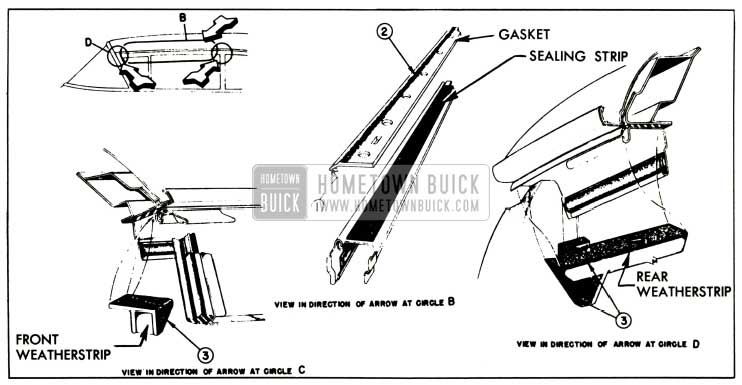
1957 Buick Side Roof Rail Mechanical Sealing Strip
Compound should compress easily so that it does not interfere with installation and operation of sealing strip.
- Position mechanical sealing strip to side roof rail and secure in place by installing all but end attaching screws.
- Apply an approved weatherstrip cement to top and end contacting surfaces of front and rear weatherstrips as indicated by “3” in figure 13-193, and install weatherstrips.
- Align sealing strip with top of 1957 Buick door window and ventilator, and tighten screws uniformly. Wipe off excess sealer.
Adjustment of 1957 Buick Side Roof Rail Mechanical Sealing Strip (Models 56R-76R)
The attaching holes in the side roof rail mechanical sealing strip assembly are elongated allowing “in” and “out” adjustment of the sealing strip; however, the amount of adjustment is small and is not intended to correct for improper ventilator or 1957 Buick door alignment. The purpose of this adjustment is to obtain the proper closing effect of the sealing strip. IMPORTANT: Before attempting to adjust the side roof rail mechanical sealing strip assembly, first check that the ventilator and door window are properly aligned and, where necessary, adjust for proper alignment as directed under “ADJUSTMENTS” in the ventilator and Door Window service procedures.
- Loosen sealing strip attaching screws.
- Adjust strip in or out as required; then tighten screws.
Lubrication of Side Roof Rail Mechanical Sealing Strip (Models 56R-76R)
In cases where the action of the outer sealing strip is sluggish due to friction with lip (awning) of the rubber gasket, apply a sparing amount of a silicone rubber lubricant along the entire length of the exposed inner lip of the gasket, as indicated at “1,” in figure 13-193.
13-31 1957 BUICK FRONT DOORS (SERIES 50-70)
NOTE: For removal and installation of 1957 Buick front door assembly, see paragraph 13-7 (a).
1957 Buick Front Door Assembly and Hinges
The front door hinges are the swing-out type with an integral door check and hold open, similar to past models. The hinges are attached to the front body hinge pillar and to the door assembly with bolts, cage nuts and anchor plates. NOTE: At both the upper and lower front door hinges one of the hinge to front body hinge pillar attaching bolt s is installed from the front of the front body pillar necessitating detachment or removal of chassis parts to gain access to the bolt s for complete removal of the hinges from the body. However, the se bolt s have a hexagon end and can be loosened from inside the hinge box thereby facilitating adjustment of the door hinge at the body pillar without removal of chassis parts.
1957 Buick Front Door Adjustments
1957 Buick door adjustments are provided through the use of floating cage nuts and anchor plates in the door and body hinge pillar. The front doors may be adjusted fore or aft at the door hinge straps and in or out at the front body hinge pillar; up or down adjustments may be made at both the door hinge straps and the front body hinge pillar.
IMPORTANT: After performing any door adjustments the door lock extension-to-striker engagement should be checked and if necessary adjusted, as described under “DOOR LOCK STRIKER ADJUSTMENTS.” In addition, the front door ventilator and window should be checked for proper alignment with the side roof rail mechanical sealing strip or the side roof rail weatherstrip and adjusted where required.
- To adjust the 1957 Buick front doors fore or aft and /or up or down proceed as follows:
- Remove 1957 Buick door trim assembly. Remove tape covering lower hinge access hole. Detach upper front edge of door inner panel water deflector sufficiently to gain access to upper hinge bolts, as shown in figure 13-194.
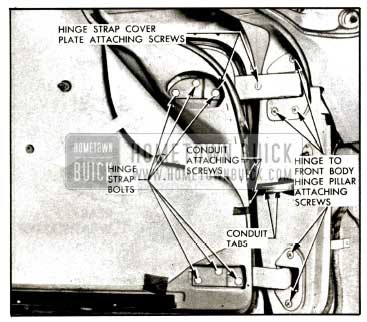
1957 Buick Front Door Hinges Illustration
- Remove 1957 Buick door lock striker from body pillar to allow the door to hang freely on the hinges.
- Scribe location of hinge straps on door.
- Loosen hinge strap bolts, as shown in figure 13-194, and shift door to desired position, then retighten bolts. NOTE: Additional up m• down adjustment may be obtained at the front body hinge pillar.
- Apply waterproof body tape over lower hinge access hole. Reseal upper front edge of inner panel water deflector, then install previously removed door trim and inside hardware.
- To adjust the front doors in or out and /or up or down at the front body hinge pillar, proceed as follows:
- Remove hinge strap cover plate attaching screws. Remove cover plate. See figure 13-194.
- Scribe location of hinge on front body hinge pillar.
- Inside both upper and lower hinge boxes loosen (turn clockwise) hinge attaching bolt installed from front of hinge pillar.
- IMPORTANT: Use a six point (single hexagon) type socket.
- Loosen hinge attaching screws at face of hinge pillar. See figure 13-194. Shift door to desired position; tighten attaching screws at face of hinge pillar, then tighten (turn counterclockwise) bolt inside hinge boxes to 40-45 ft. lbs.
- Install hinge strap cover plate. Reseal water deflector to inner panel and install door trim and hardware parts.
1957 Buick Front Door Locking Mechanism
All locks are the rotary bolt type lock with the inter lock feature. With the inter lock feature it is very important that the lock extension engages properly in the door lock striker notch and that, where necessary, striker emergency spacers of the proper thickness are used to obtain proper engagement.
On the four-door sedans an adjusting nut is provided at the lower end of the door outside handle connecting rod which can be adjusted to provide proper action of the outside handle push button.
1957 Buick Door Lock Spring Clip
A redesigned spring clip is used on the 1957 Buick door lock levers to secure the connecting rods to the lock levers. A slot in the spring clip provides easy disengagement of the clip, thereby facilitating detachment of the lock connecting rods from the lock.
To disengage spring clips, use a screw driver or other suitable tool to slide the clip out of engagement. Figure 13-195 shows a 1957 Buick door lock spring clip engaged and disengaged.
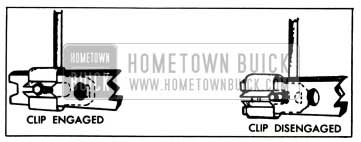
1957 Buick Door Lock Spring Clips
Removal and Installation of 1957 Buick Door Lock (Two-Door Models)
- Remove the 1957 Buick door window assembly as described under “FRONT DOOR WINDOW ASSEMBLY.” Remove two screws securing glass run channel to lock pillar and remove channel.
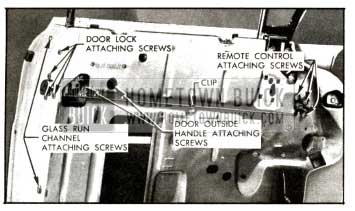
1957 Buick Front Door Lock Mechanisms
- Through large access hole detach spring clip securing lock cylinder connecting rod to lock and detach lock cylinder connecting rod from lock lever.
- Remove remote control attaching screws. Detach remote control from connecting rod, detach rod from clip on door inner panel; then disengage rod from door lock.
- Remove four door lock attaching screws from face of door lock pillar and remove lock from door through large access hole: NOTE: The inside locking rod can be detached from lock after lock is removed from door.
- Prior to installation of front door lock, apply a ribbon of body caulking compound (approximately 1/4 inch in diameter) across face of lock frame approximately 3/4 inch from above the rotary bolt housing, as indicated in figure 13-197.
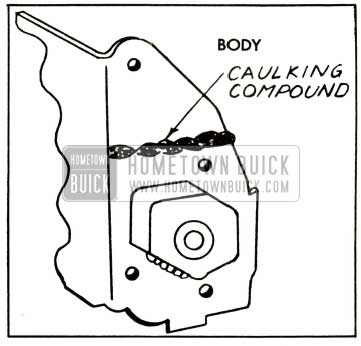
1957 Buick Door Lock Sealing Illustration
- To install 1957 Buick front door lock reverse removal procedure.
Removal and Installation of 1957 Buick Front Door Lock (Four-Door Models)
- Raise 1957 Buick door window. Remove door trim assembly and door inner panel water deflector.
- Remove glass run channel attaching screws on face of lock pillar. See figure 13-198.
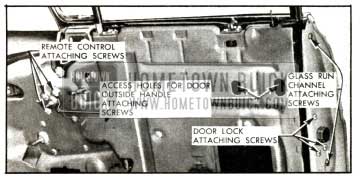
1957 Buick Front Door Lock Mechanism
Lower glass run channel from behind window frame extension and remove from 1957 Buick door.
- Through large access hole disengage spring clips securing lock cylinder connecting rod, inside locking rod, remote control connecting rod and push button connecting rod to lock and detach rods from lock. See figure 13-199.
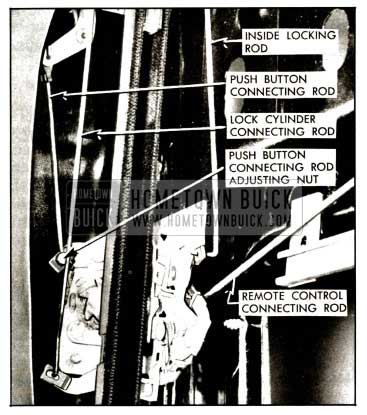
1957 Buick Front Door Locking Mechanism Illustration
- Remove lock attaching screws from face of door lock pillar, as shown in figure 13-198, and remove lock from door through large access hole.
- Prior to installation of front door lock, apply ribbon of medium-bodied sealer (approximately 1/4 inch in diameter) across face of lock frame approximately 3/4 inch above rotary bolt housing, as indicated in figure 13-197.
To install 1957 Buick front door lock, reverse removal procedure. Adjust push button connecting rod adjusting nut to provide between 1/32″ to 1/8″ free travel of push button.
Check all operations of door lock before installing door inner panel water deflector, door trim assembly and inside hardware.
1957 Buick Front Door Lock Remote Control and Connecting Rod
- Raise 1957 Buick front door window and remove door trim assembly.
- Detach water deflector sufficiently to gain access to remote control attaching screws; and on four door styles to inner panel rear access hole.
- Remove remote control attaching screws, as shown in figure 13-198, and detach remote control from connecting rod.
- On two-doors detach remote control connecting rod from clip on inner panel and remove rod and anti-rattle clip from lock. See figure 13-196.
- On four-doors disengage spring clip at lock lever, detach rod from lock, and remove rod from door through forward access hole.
- To install front door lock remote control, reverse removal procedure.
Adjustment of 1957 Buick Front Door Lock Remote Control and Connecting Rod
- Raise 1957 Buick front door window and remove door trim assembly.
- Detach upper portion of inner panel water deflector sufficiently to gain access to remote control attaching screws.
- Loosen three remote control attaching screws. Move remote control to forward position, then adjust remote control rearward sufficiently to take up slack in linkage. Check operation of remote control before installing water deflector and readjust if necessary.
Removal of 1957 Buick Front Door Outside Handle
- Raise door window. Remove door trim assembly and door inner panel water deflector.
- Through rear access hole on all styles disengage spring clip and detach lock cylinder connecting rod from lock. On four-doors, disengage spring clip and detach push button connecting rod and adjusting nut from lock lever. See figure 13-199.
- Through access holes at upper rear of door, as shown in figure 13-198, remove handle attaching screws; then remove handle and gaskets with attached connecting rods from 1957 Buick door.
- As a bench operation remove connecting rods and anti-rattle clips from handle.
Installation of 1957 Buick Front Door Outside Handle
To install 1957 Buick door outside handle, reverse removal procedure making sure handle gaskets are installed between handle and door outer panel. On four-doors adjust the push button connecting rod adjusting nut to provide between 1/32″ to 1/8″ free travel of the push button. Check all operations of door lock before installing door inner panel water deflector, 1957 Buick door trim assembly and inside hardware.
Disassembly of 1957 Buick Front Door Outside Handle Assembly
- Remove 1957 Buick door outside handle as previously described.
- While maintaining pressure to hold component parts within handle, use a suitable tool and remove spring retainer, then remove parts as shown in figure 13-200 for two-doors, or figure 13-201 for four-doors.

1957 Buick Disassembly of Front Door Outside Handle-Two-Door Models

1957 Buick Disassembly of Front Door Outside Handle-Four-Door Models
- To disengage pawl from stop washer retainer on two-doors rotate pawl to proper cutouts in stop washer retainer and remove.
- On four-doors, to disengage bell crank lever from pawl rotate bell crank lever to proper cut-outs in pawl and remove.
- (a) To assemble 1957 Buick door outside handle assembly on two-doors first engage pawl to stop washer retainer; then reverse above procedure making certain open end of spring retainer is located at nipple on stop washer retainer. Figure 13-202 shows handle assembled.
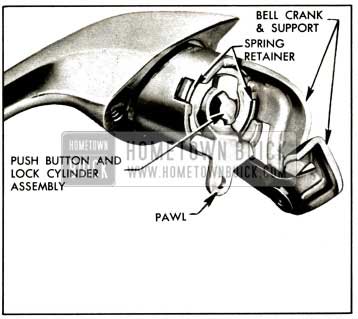
1957 Buick Front Door Outside Handle Assembly-Four-Door Models
- To assemble 1957 Buick door outside handle on four door styles first engage pawl to bell crank support; then reverse above procedure making certain open end of spring retainer is located at nipple on pawl. Figure 13-203 shows the handle assembled.
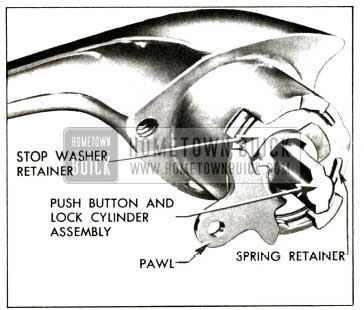
1957 Buick Front Door Outside Handle Assembly-Two-Door Models
Removal and Installation of 1957 Buick Front Door Lock Cylinder
The 1957 Buick front door lock cylinder is located in the door lock outside handle push button assembly. To remove lock cylinder, it is necessary to remove the push button from the handle.
- Remove and disassemble 1957 Buick door outside handle as previously described.
- With a suitable tool remove detent washer from lock cylinder.
- Carefully bend out tabs securing lock cylinder cap and remove lock cylinder sleeve and lock cylinder.
- To assemble, reverse removal procedure.

1957 Buick Front Door Lock Cylinder
CAUTION: When installing detent spring make certain raised portions of spring rest in depressions in sleeve.
Removal and Installation of 1957 Buick Front Door Inside Locking Rod
- Raise front door window and remove door trim assembly.
- Detach rear portion of inner panel water deflector sufficiently to gain access to inner panel rear access hole.
- On two-doors proceed as follows:
- Remove glass run channel inner strip assembly secured by three screws at top of inner panel.
- Swing inside locking rod down between door panels sufficiently to detach rod and anti-rattle clip from lock lever.
NOTE: It may be necessary to lower window and / or remove the window rear cushion and adjusting plate at top of inner panel to swing rod down between door panels.
- On four-doors proceed as follows:
Working through rear access hole disengage spring clip and detach inside locking rod from lock as shown in Figure 13-199; then remove rod from door.
- To install front door inside locking rod, reverse removal procedure.
Removal and Installation of 1957 Buick Front Door Ventilator Assembly
- Lower 1957 Buick door window. Remove door trim assembly and inner panel deflector.
- Remove screws, indicated in Figure 13-205, securing weatherstrip tabs to ventilator.
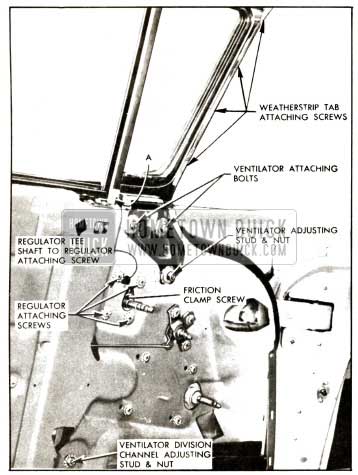
1957 Buick Front Door Ventilator and Ventilator Regulator
- Loosen ventilator tee shaft to regulator shaft screw through access hole, shown in Figure 13-205, and loosen ventilator regulator attaching bolts.
- Remove ventilator division channel lower adjusting stud and nut as shown in Figure 13-205.
- Remove screw, indicated at “A”, securing ventilator frame to return flange of door outer panel. Remove ventilator attaching bolts and adjusting stud and nut as shown in Figure 13-205.
- Disengage ventilator tee shaft from regulator shaft; then carefully work front of ventilator inboard sufficiently to clear door inner panel (at cove area). Lift ventilator upward and remove from 1957 Buick door.
NOTE: It may be necessary to raise window slightly to work front of ventilator clear of door inner panel.
- To install ventilator assembly, reverse removal procedure.
Adjustment of 1957 Buick Front Door Ventilator Assembly
The ventilator assembly can be adjusted in all directions to provide proper contact with the side roof rail weatherstip, the front body windshield pillar, and the door window glass.
To adjust the ventilator assembly proceed as follows:
- Remove 1957 Buick door trim assembly and detach inner panel water reflector sufficiently to gain access to ventilator and ventilator regulator attaching bolts and screws, and ventilator division channel lower adjusting stud and nut.
- Remove screw indicated at “A” in Figure 13-205 securing ventilator frame to return flange of 1957 Buick door outer panel.
- Loosen ventilator tee shaft to regulator shaft attaching screw as shown in Figure 13-205.
- Loosen ventilator frame attaching bolts and adjusting stud nut. Loosen ventilator division channel adjusting stud nut.
- (a) To adjust upper portion of ventilator in or out for proper contact with the side roof rail weatherstrip, turn ventilator frame adjusting stud and ventilator division channel adjusting stud in or out as required, then tighten stud nuts and all attaching bolts.
- To adjust ventilator assembly up or down and /or fore or aft for proper alignment with the side roof rail weatherstrip, front body windshield pillar and door window, position entire ventilator assembly, as required, then tighten all attaching bolts and stud nuts as shown in Figure 13-205.
- Install screw at “A” securing ventilator frame to return flange of 1957 Buick door outer panel. Tighten ventilator tee shaft-to-regulator shaft screw. Seal water deflector to door inner panel and install door trim and inside hardware.
Removal and Installation of 1957 Buick Front Door Ventilator Regulator Assembly
- Raise 1957 Buick door window. Remove door trim assembly and inner panel water deflector.
- Remove ventilator tee shaft to regulator shaft at aching screw.
- Remove ventilator regulator attaching screws. See Figure 13-205.
- Disengage regulator shaft from ventilator tee shaft. Remove ventilator regulator through front access hole.
NOTE: In some cases, it may be necessary to loosen the complete ventilator assembly and lift the assembly upward sufficiently to allow disengagement of regulator shaft from ventilator tee shaft.
- To install ventilator regulator, reverse removal procedure.
Adjustment of Front Door Ventilator Regulator Assembly
Excessive “play” (flutter) of the ventilator at the pivot shaft when the ventilator is in the open position can be corrected by tightening the ventilator tee shaft-to-regulator shaft screw. See figure 13-205.
CAUTION: Screw should be tightened carefully to avoid stripping threads in regulator spiral gear shaft.
The operating effort required to open or close the ventilator can be slightly increased or decreased by adjusting the friction clamp screw.
Removal and Installation of Front Door Window (Manual and Electric)
- Raise 1957 Buick door glass. Remove door trim assembly and inner panel water deflector.
- On two-doors, remove glass run channel inner sealing strip secured to top of door inner panel with three screws. On all Series 50-70, loosen window cushion adjusting plates and position plates inboard. See figure 13-206.
- Remove window lower sash channel front stop attaching screws through access hole “A”. See Figure 13-206.
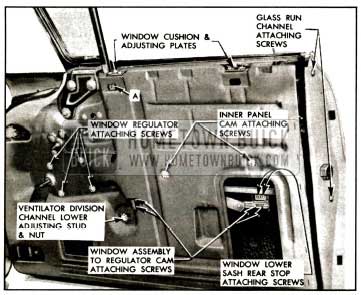
1957 Buick Front Door Window and Window Regulator
- Lower window; remove lower sash channel rear stop and four screws securing window assembly to regulator cam. See Figure 13-206.
- Disengage window assembly from regulator cam and lift door glass upward and remove from door.
CAUTION: DO NOT OPERATE REGULATOR MOTOR after the window assembly is disengaged from the regulator. Operation of the motor with the load removed may damage the unit and make it inoperative.
- To install window assembly, reverse removal procedure.
Adjustment of 1957 Buick Front Door Window (Manual and Electric)
To adjust the 1957 Buick door window glass for proper contact with the side roof rail weatherstrip and with the rear door window frame weatherstrip as shown in Figure 13-217; or to relieve a binding door glass caused by misalignment of the glass with the glass run channels, proceed as follows:
- To correct a condition where the glass is “cocked” in the glass run channels, loosen the inner panel cam rear attaching screw. . See figure 13-206. Adjust rear of cam up or down as required to retighten screw.
- To adjust the upper front portion of the window in or out for proper contact with the side roof rail weatherstrip, adjust top of ventilator assembly in or out as described under “FRONT DOOR VENTILATOR ADJUSTMENTS”.
- To adjust the lower portion of the ventilator division channel for alignment with the window, loosen ventilator division channel adjusting stud nut. See figure 13-206. Turn adjusting stud in or out or position lower end of channel fore or aft, as required; then, retighten adjusting stud nut.
- To adjust rear of window upper frame in or out for proper contact with the side roof rail weatherstrip or to adjust rear of window in or out at belt line, loosen glass run channel attaching screws. Position channel as required and retighten screws.
- To adjust limit of “up” travel of the window for proper contact with the side roof rail weatherstrip, adjust window cushion and adjusting plates. See figure 13-206.
Removal and Installation of 1957 Buick Front Door Window Glass Run Channel
- Raise 1957 Buick door window. Remove door trim assembly and detach rear portion of inner panel water deflector.
- Remove glass run channel attaching screws. See figure 13-206.
- Working through rear access hole lower glass run channel from behind window frame extension and remove from door.
- To install 1957 Buick door glass run channel, reverse removal procedure.
Removal and Installation of 1957 Buick Front Door Window Regulator (Manual and Electric)
- Lower 1957 Buick door window. Remove door trim assembly and inner panel water deflector.
- On 1957 Buick doors with electrically-operated windows, disconnect wiring harness connector from regulator motor through front access hole.
- Remove window assembly to regulator cam attaching screws. See figure 13-206. Raise window and prop in up position.
- Remove ventilator division channel lower adjusting stud and nut.
- Remove inner panel cam attaching screws. Detach cam from regulator arm and remove from 1957 Buick door.
- Remove regulator attaching screws. See figure 13-206. Carefully work regulator assembly through rear access hole and remove from door. Do not operate regulator motor after window regulator is removed from the door. Operation of motor with the load removed may damage the unit or make it inoperative. NOTE: Instructions for removing the motor from the regulator assembly are outlined under “FRONT DOOR WINDOW REGULATOR ELECTRIC MOTOR ASSEMBLY”.
- To install front door window regulator, reverse removal procedure.
Removal and Installation of 1957 Buick Front Door Window Regulator Electric Motor
The electric motor assembly which powers the 1957 Buick door window regulator is a reversible type motor with a built-in circuit breaker and a self-locking gear drive. The motor is secured to the regulator assembly with three screws. Operating principles of the regulator are such that when the motor is actuated, the motor pinion gear, which is meshed with the rack portion of the regulator sector, rotates, providing the up and down movement of the regulator lift arm. The illustration shows the door window regulator removed from the body. (Figure 13-207.)
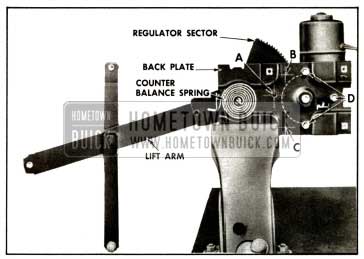
1957 Buick Electric Window Regulator
- Remove electric window regulator assembly from door and clamp securely in vise.
NOTE: The position of the regulator clamped in the vise will vary with the type of regulator and position of the lift arm. CAUTION: Be sure to perform Steps 2 and 3 before attempting to remove the motor assembly from the regulator. The regulator lift arm, which is under tension from the counter-balance spring, can cause serious injury if the motor assembly is removed without locking the sector in position.
- Drill 1/4″ hole through backplate and sector within area at “A”, as indicated in figure 13-207.
NOTE: Do not drill into motor housing, part of which is indicated by the dotted lines. In addition, locate hole not less than 3/4″ away from edge of backplate or sector.
- Insert 3/16″ bolt through holes in backplate and sector and install nut to bolt. (Do not tighten nut.)
- Remove the three attaching bolts as shown in figure 13-207 and remove motor assembly from regulator. NOTE: Clean steel chips off the regulator sector and motor pinion gear.
- To install, reverse removal procedure.
NOTE: Be sure to remove nut and bolt before reinstalling regulator.
13-32 1957 BUICK REAR DOORS (SERIES 50-70)
Removal of 1957 Buick Rear Door Assembly and Hinges
The 1957 Buick rear door assembly is attached to the body center pillar with two butt type hinges. The lower hinge has an integral door check and hold open and is secured to an anchor plate at the door and at the hinge pillar by three screws at each location. The upper hinge is secured to an anchor plate on the door hinge pillar by three screws and to the upper hinge support on the center pillar by three bolts.
Either of the following two methods can be used to remove the door from the body: The 1957 Buick door can be removed from the hinge straps, or the door and hinge straps can be removed from the center pillar.
- Operate window to down position.
- Clean off excess sealer around each hinge strap and scribe location of hinge strap on door hinge pillar or center pillar depending on method of removal being used.
- On doors with electrically operated windows proceed as follows:
- Remove 1957 Buick door trim assembly.
- Detach water deflector sufficiently to gain entrance to large access hole.
- Remove two screws securing electrical conduit to door hinge pillar, bend down tabs securing harness to conduit and remove conduit. Through access hole disconnect wire harness connector from window regulator motor and remove wire harness from door.
- Depending on method of removal, properly support door and remove three upper and three lower hinge attaching screws “A” and “B” at door hinge pillar or three screws “C” and three bolts “D” which secure hinges to center pillar as indicated in figure 13-208.
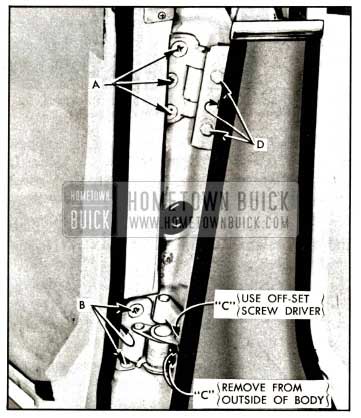
1957 Buick Rear Door Hinges Illustration
NOTE:
If lower hinge strap is being removed from center pillar, the upper attaching screw can be reached between inside of door and center pillar with an off-set screw driver. The two lower attaching screws can be reached between outside of the door and center pillar.
- With aid of a helper remove 1957 Buick door from body opening.
Installation of 1957 Buick Rear Door Assembly and Hinges
- With scraper and mineral spirits, clean off old sealing compound at hinge areas. CAUTION: This operation should be performed carefully to avoid possibility of soiling adjacent trim material.
- Apply a coat of heavy-bodied sealer to attaching surfaces of hinge straps or to corresponding surfaces of door or body, as indicated in figure 13-209.
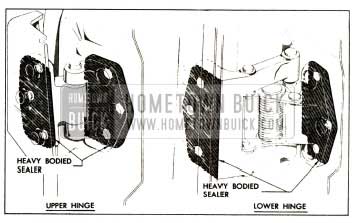
1957 Buick Sealing Rear Door Hinges Procedure
It is important to obtain complete coverage to insure both maximum sealing and anti-squeak effects.
- With helper, lift 1957 Buick door into position. Install screws and bolts loosely, then align straps within scribe mark on pillar and tighten screws and bolts. Check door for alignment.
- On doors with electrically operated windows proceed as follows:
- Install wire harness to attaching clips inside of door and attach connector to motor. Check operation of window.
- Install conduit to hinge pillar and secure wire harness and lighter wire, if present, in conduit with retaining tabs.
- Reseal water deflector to inner panel as specified under “Door Inner Panel Water Deflector.”
- Install door trim assembly and previously removed door hardware.
1957 Buick Rear Door Adjustments
The 1957 Buick rear door hinge adjustments differ from those performed on previous models. “In” and “out” and “up” and “down” adjustments are provided at the door hinge pillar. “Fore” and “aft” adjustments are provided for at the body center pillar.
When checking the door for alignment, remove the door lock striker from the body pillar to allow the 1957 Buick door to hang free on its hinges.
NOTE: After performing any adjustments the rear door window should be checked for proper alignment with the side roof rail weatherstrip and adjusted where required. In addition the door lock extension-to-striker engagement should be checked and adjusted, where necessary, as described under “DOOR LOCK STRIKER ADJUSTMENTS.”
- For “in” and “out” or “up” and “down” adjustments loosen screws “A” and “B” (figure 13-208) securing hinges to door hinge pillar, adjust door as required, and tighten screws.
NOTE: When performing “in” and “out” adjustments, adjust one hinge at a time so that the same “up” and “down” adjustment is maintained.
- To adjust the “fore” and “aft”, loosen screws “C” and bolts “D” (figure 13-208) securing hinges to center pillar, adjust 1957 Buick door as required, and tighten screws and bolts.
NOTE: An off-set screwdriver is required to reach the upper attaching screw on the lower hinge.
1957 Buick Rear Door Locking Mechanisms
All 1957 Buick door locks are the rotary bolt type lock with the inter-lock feature. With the interlock feature it is very important that the lock extension engages properly in the striker notch and that, where necessary, striker emergency spacers of the proper thickness are used to obtain proper engagement.
An adjusting nut is provided at the lower end of the 1957 Buick door outside handle connecting rod, which can be adjusted to provide proper action of the outside handle push button.
1957 Buick Door Lock Spring Clip
A redesigned spring clip is used on the 1957 Buick door lock levers to secure the connecting rods to the lock levers. A slot in the spring clip provides easier disengagement of the clip thereby facilitating easier detachment of the lock connecting rods from the lock.
To disengage spring clips, use a screw driver or other suitable tool to slide clip out of engagement. Figure 13-210 shows a door lock spring clip engaged and disengaged.
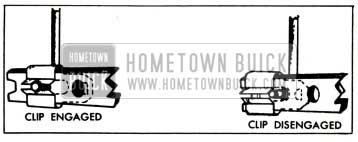
1957 Buick Door Lock Spring Clip View
Removal and Installation of 1957 Buick Rear Door Lock
- Raise 1957 Buick door window. Remove door trim assembly and inner panel water deflector.
- Through large access hole disengage spring clips at “A”, “B” and “C” and detach connecting rods from door lock. See figure 13-211.
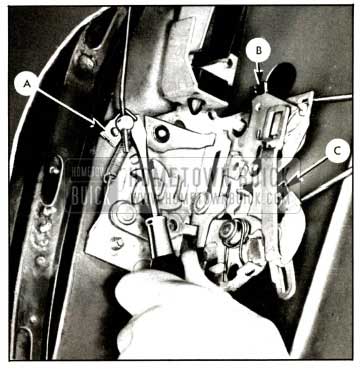
1957 Buick Rear Door Lock Connecting Rod Attachments
- Remove door lock attaching screws (figure 13-212) and remove lock from door through access hole.
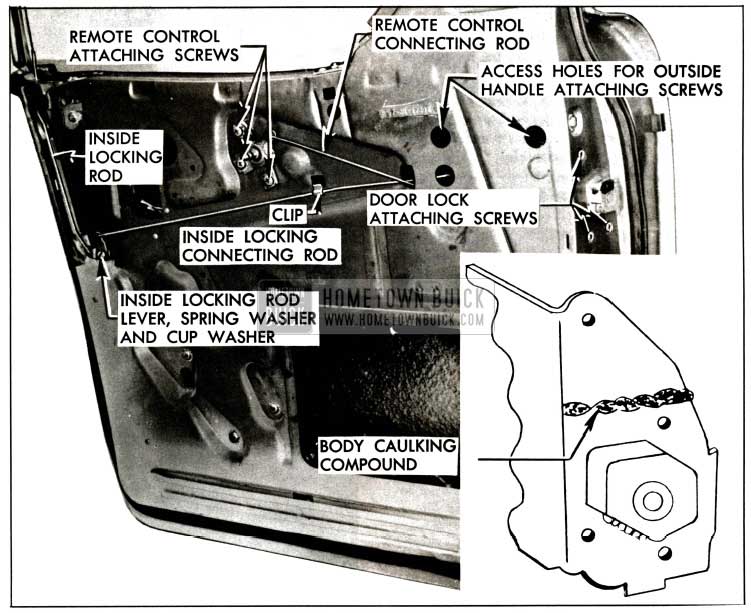
1957 Buick Rear Door lock Mechanisms
- To install 1957 Buick door lock, reverse removal procedure. Prior to installation of lock, apply a ribbon of body caulking compound (approximately 1/4 inch in diameter) across face of lock frame approximately 3/4 inch above rotary bolt housing, as indicated in figure 13-212.
Adjust the push button connecting rod adjusting nut to provide between 1/32″ to 1/8″ free travel of the push button.
Check all operations of 1957 Buick door lock before installing door inner panel water deflector, door trim assembly and inside hardware.
Removal and Installation 1957 Buick Rear Door Lock Remote Control and Connecting Rod
- Raise 1957 Buick door window. Remove door trim assembly and detach upper portion of inner panel water deflector sufficiently to gain access to remote control attaching screws. See figure 13-212.
- Remove remote control attaching screws and detach remote control from connecting rod.
- To remove remote control connecting rod, remove door inner panel water deflector. Through inner panel access hole disengage spring clip at “C” (figure 13-212) and detach connecting rod from lock.
- To install remote control and connecting rod, reverse removal procedure. Position remote control rearward sufficiently to take up slack in linkage so that all clearances are taken out of the linkage in a rearward position. Check all operations of 1957 Buick door lock before installing door trim and inside hardware.
- To adjust remote control and connecting rod, raise door window. Remove door trim assembly and detach upper portion of inner panel water deflector sufficiently to gain access to remote control attaching screws.
- Loosen remote control attaching screws. See figure 13-212. Move remote control to forward position; then adjust remote control rearward sufficiently to take up slack in linkage.
Removal and Installation of Rear Door Outside Handle
- Raise 1957 Buick door window. Remove door trim assembly and inner panel water deflector.
- Through large access hole disengage spring clip “A” (figure 13-211) and detach adjusting nut and attached connecting rod from lock.
- Through access holes for handle attaching screws (figure 13 212 ), remove attaching screws and remove handle with attached push button connecting rod from door.
- To install door outside handle, reverse removal procedure making sure front and rear gaskets are installed between handle and door outer panel.
- Adjust the push button connecting rod adjusting nut to provide between ‘1/32″ to 1/8″ free travel of push button.
- Check all operations of door lock before installing door inner panel water deflector, door trim assembly, and inside hardware.
Disassembly and Assembly of Rear Door Outside Handle
- Remove rear door outside handle and remove push button connecting rod from handle.
- Remove spring retainer, bell crank and support, stop washer, spring, push button and shaft, and sealing washer. See figure 13-213.

1957 Buick Rear Door Outside Handle-Disassembly and Assembly
- To assemble rear door outside handle, reverse removal procedure making sure front and rear gaskets are installed between handle and door outer panel.
- Adjust the push button connecting rod adjusting nut to provide between 1/32″ to 1/8″ free travel of the push button.
- Check all operations of door lock before installing 1957 Buick door inner panel water deflector, door trim assembly and inside hardware.
Removal and Installation of 1957 Buick Rear Door Inside Locking Rod, Lever and Connecting Rod
- Remove 1957 Buick door trim assembly. Detach upper portion of inner panel water deflector sufficiently to gain access to inside locking rod, lever ‘and connecting rod.
- Remove inside locking rod lever attaching screw, spring washer and cup washer. See figure 13-212. Pull locking rod lever from inner panel sufficiently to detach inside locking rod from lever.
- To remove inside locking connecting rod, proceed as follows:
- Remove inner panel water deflector.
- Through large access hole disengage spring clip at “B” (figure 13-211) and detach connecting rod from lock. Detach rod from clip at inner panel and remove from 1957 Buick door.
- To install inside locking rod, lever and connecting rod, reverse removal procedure. Check all operations of door lock before installing inner panel water deflector, door trim and inside hardware.
1957 Buick Rear Door Lock Free-Wheeling Adjustment
When the inside locking rod is in the down position and the lock is set in free-wheeling, it prevents the door from being opened by the operation of the inside remote control handle.
The tool required to perform the free-wheeling adjustment can be made from a piece of rod approximately 1/8″ in diameter. To make tool, cut rod approximately 7″ length, then bend 3/8″ of rod at one end to form a right angle. The rear door lock may be adjusted “in” or “out” of free-wheeling as follows:
- Lower door window, pull inside locking rod knob to “up” position and remove rear door lock upper attaching screw.
- Insert adjusting tool through screw hole. See figure 13-214.
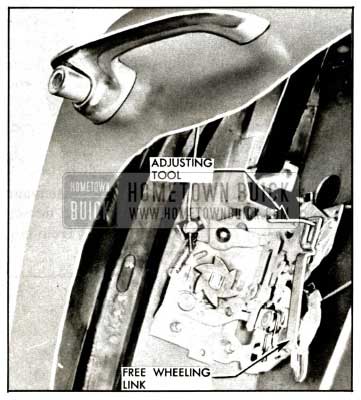
1957 Buick Rear Door Lock Free-Wheeling Adjustment
- While observing through the window opening, with the aid of a light, engage hooked end of adjusting tool in cut-out of free-wheeling link, as shown in figure 13-214. Pull link REARWARD to set lock “OUT” of freewheeling and push link FORWARD to set lock “IN” free-wheeling.
NOTE: Check all operations of door lock after making a free-wheeling adjustment.
1957 Buick Rear Door Window and Window Regulator
The 1957 Buick rear door window and window regulator on all four-doors are of a new design providing easy service operations and adjustments. To obtain a thorough knowledge of the new window and window regulator the following illustration should be studied to become familiar with the parts and their locations. The parts may be located in the cut-away illustration (figure 13-215) by letters and arrows.
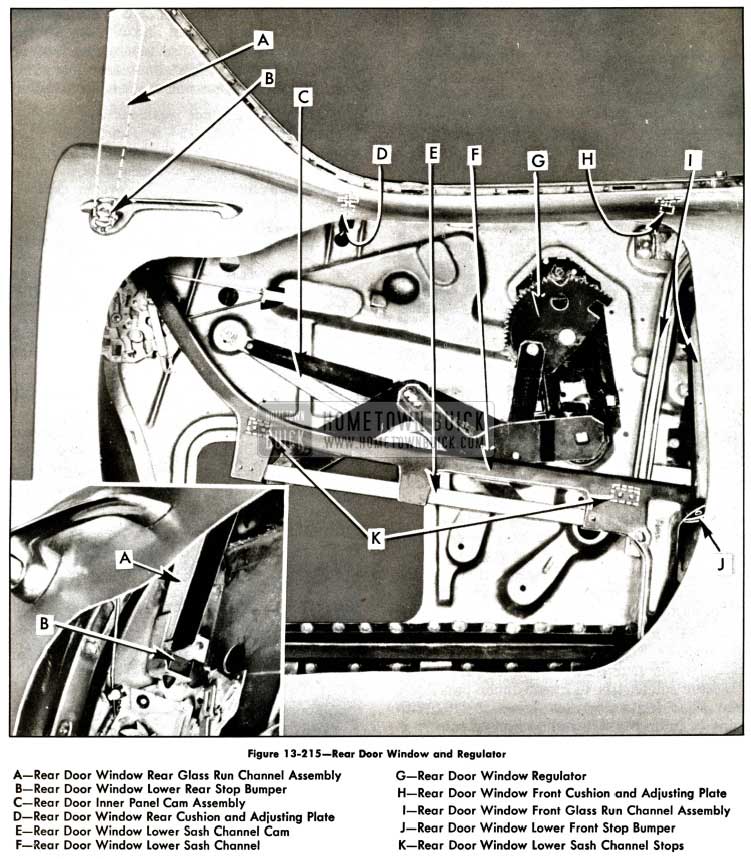
1957 Buick Rear Door Window and Regulator
Removal and Installation of 1957 Buick Rear Door Window Assembly (Manual and Electric)
NOTE: The rear door window glass may be removed and installed without removing the window assembly by removing the window upper sash channel frame and removing the glass from the lower and front sash channel frame.
- Raise 1957 Buick door window. Remove door trim assembly and inner panel water deflector.
- Loosen the rear door window front and rear cushion adjusting plate. See figure 13-216.
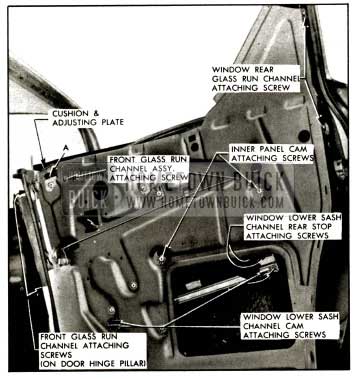
1957 Buick Rear Door Window Removal and Adjustments
- Remove window lower sash channel front stop attaching screws through access hole “A”. See figure 13-216.
- Lower door window; remove window lower sash channel rear stop. Loosen front glass run channel cam attaching screw.
- Remove window lower sash channel cam attaching screws. See figure 13-216 and disengage window assembly from sash channel cam.
- Lift window assembly upward. Disengage roller at front of window lower sash channel from front glass run channel and remove window from between door panels.
- To install window assembly, reverse removal procedure. Before installing window assembly apply (brush) Lubriplate along full length of the front glass run channel cam.
1957 Buick Rear Door Window Adjustments
IMPORTANT: The 1957 Buick rear door assembly should be properly aligned in the body opening before adjusting the rear door window.
Adjustments have been provided to insure proper contact of the rear door window frame with the side roof rail weatherstrip and proper contact of the rear door window front frame weatherstrip with the front door window frame as shown in figure 13-217; also to insure proper operation of the window.
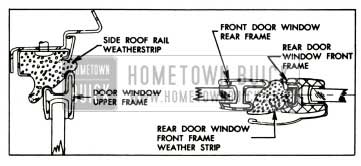
1957 Buick Rear Door Window Alignment
- “IN” and “OUT” adjustment of the window: Loosen the front and/or rear glass run channel attaching screws at the door pillars, as shown in figure 13-216. Adjust channels “in” or “out” as required, then tighten attaching screws. Operate window and check adjustment.
- “FORE” and “AFT” adjustment of the window: Remove door belt finishing molding and detach upper front corner of door inner panel water deflector sufficiently to loosen front glass run channel cam attaching screw. With window in “up” position adjust glass run channel “fore” or “aft” as required, then tighten cam attaching screw. Operate window and check adjustment.
- “UP” and “DOWN” adjustment of front of window: Remove door trim assembly and detach upper rear portion of inner panel water deflector sufficiently to loosen inner panel cam rear attaching screw. See figure 13-216. With window in up position adjust rear of cam “up” or “down” as required, then tighten cam attaching screw. Operate window and check adjustment.
- “UP” limit adjustment of front and/or rear of window: Remove door belt finishing molding. Loosen the front and /or rear cushion screw lock nut; adjust cushion screw “up” or “down” for proper “up” limit travel of window. Operate window and check adjustment.
NOTE: Check that cushions are making proper contact with the window lower sash channel strips. If necessary loosen cushion adjusting plate attaching screws and adjust plate and cushion “in” or “out” for proper contact.
Removal of 1957 Buick Rear Door Window Front Glass Run Channel Assembly
- Remove 1957 Buick rear door window assembly, as described under “REAR DOOR WINDOW ASSEMBLY-Removal and Installation”.
- Remove front glass run channel attaching screw at inner panel and attaching screws at door hinge pillar. See figure 13-216.
- Remove glass run channel assembly through large access hole.
- To install 1957 Buick door window front glass run channel assembly, reverse removal procedure.
Prior to installing channel assembly, apply (brush) Lubriplate along full length of the channel cam.
Before installing inner panel water deflector, check window operation and alignment, and where necessary, adjust window as described under “REAR DOOR WINDOW ADJUSTMENTS”.
Removal and Installation of 1957 Buick Rear Door Window Rear Glass Run Channel Assembly
- Raise 1957 Buick door window. Remove door trim assembly and inner panel water deflector.
- Remove window rear glass run channel attaching screws (figure 13-216) and remove channel through large access hole.
- To install window rear glass run channel assembly, reverse removal procedure.
Before installing inner panel water deflector, check window alignment and, where required, adjust window as described under “REAR DOOR WINDOW ADJUSTMENTS”.
Removal and Installation of Electric Rear Door Window Regulator
- Lower 1957 Buick door window. Remove door trim assembly and inner panel water deflector. Disconnect wire harness connector from window regulator motor.
- Remove window lower sash channel cam attaching screws. See figure 13-218.
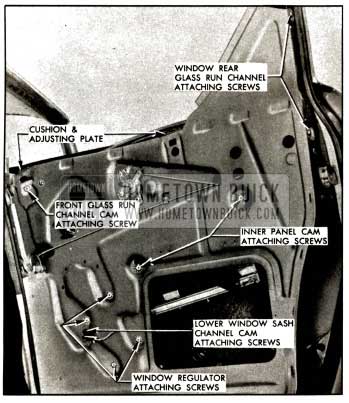
1957 Buick Rear Door Regulator Removal
Disengage window assembly from sash channel cam; then lift window assembly and prop in up position. Detach sash channel cam from regulator arms and remove cam from door.
- Remove inner panel cam attaching screws. See figure 13-218. Detach cam from regulator arm and remove from floor.
- Remove window regulator attaching screws and remove regulator assembly from door through large access hole.
CAUTION: Do not operate regulator motor after the regulator is removed from the 1957 Buick door. Operation of the motor with the load removed may damage the unit.
To remove electric motor from regulator assembly see “REAR DOOR WINDOW REGULATOR ELECTRIC MOTOR ASSEMBLY – Removal and Installation”.
- To install window regulator, reverse removal procedure.
Before installing inner panel water deflector, check window operation and alignment, and where required, adjust window as described under “REAR DOOR WINDOW ADJUSTMENTS”.
Removal and Installation of 1957 Buick Rear Door Window Regulator Electric Motor
The electric motor assembly which powers the window regulator on electrically-operated windows is a 12-volt reversible type motor with a built-in type circuit breaker and a self-locking gear drive. The motor is attached to the regulator assembly with three screws.
- Remove electric window regulator assembly from door and clamp securely in a vise, as shown in figure 13-219.
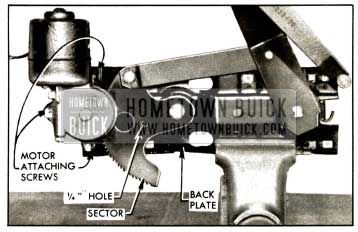
1957 Buick Rear Door Window Electric Motor
CAUTION: Be sure to perform steps 2 and 3 before attempting to remove the motor from the regulator.
The regulator lift arm, which is under tension from the counter-balance spring can cause serious injury, if the motor is removed without locking the sector in position.
- Drill a 1/4″ hole through sector and backplate at location indicated in figure 13-219.
NOTE: Location of hole in backplate will vary depending on position of sector. Do not locate hole less than 1/2″ away from edge of backplate or sector.
- Insert a 3/16″ bolt through hole in backplate and sector and install nut to bolt. (Do not tighten nut.)
- Remove the three motor attaching bolts and remove motor assembly from regulator.
NOTE: Clean off steel chips from regulator sector and motor pinion gear after drilling operation.
- To install, reverse removal procedure. NOTE: Be sure to remove temporary nut and bolt from regulator after motor is installed.
13-33 1957 BUICK CENTER PILLAR (SERIES 50-70)
Removal of 1957 Buick Center Pillar Trim
The edges of the 1957 Buick center pillar trim are cemented over the center pillar front and rear pinchweld flanges while the bottom of the trim assembly is cemented to the floor pan. Additional retention is obtained through the use of a front and rear pinchweld finishing molding and a finishing molding cap.
- Remove screws securing finishing molding cap and front and rear pinchweld finishing moldings; then remove cap, finishing moldings and finishing molding spacer clips.
- Remove front door sill plate and pull back carpet sufficiently to expose lower portion of center pillar trim.
- Carefully detach trim cemented to each pinchweld flange and lower portion of trim cemented to floor pan. Remove trim assembly from body.
Installation of Center Pillar Trim
- Clean off old cement from center pillar pinchweld flanges and from floor pan to insure a smooth cementing surface.
- Apply trim cement to inside edges of trim which contact pinchweld flanges and to bottom of trim assembly which contacts floor pan.
- Carefully position trim assembly on center pillar making certain sew lines on center pillar trim match sew lines on 1957 Buick door trim.
NOTE: If wadding is used under trim assembly sew line will butt against lower edge of wadding.
- Cement edges of trim to pinchweld flanges and to floor pan. Install pinchweld finishing moldings and spacer clips, and finishing cap. Replace carpeting and install sill plate.
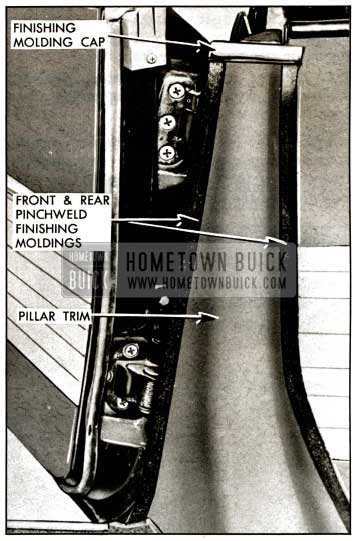
1957 Buick Center Pillar

Leave A Comment
You must be logged in to post a comment.